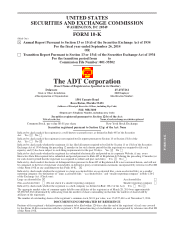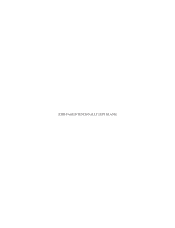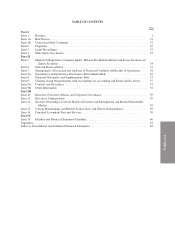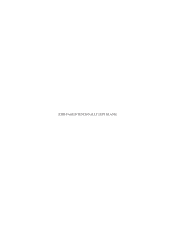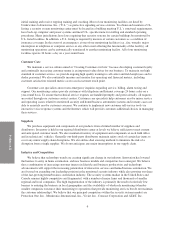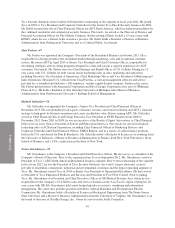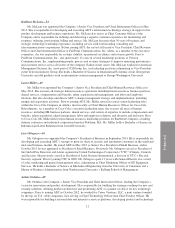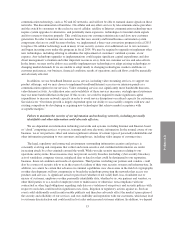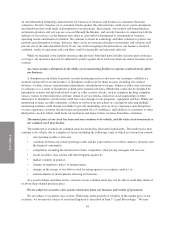ADT 2014 Annual Report Download - page 72
Download and view the complete annual report
Please find page 72 of the 2014 ADT annual report below. You can navigate through the pages in the report by either clicking on the pages listed below, or by using the keyword search tool below to find specific information within the annual report.
FORM 10-K
initial training and receive ongoing training and coaching. Most of our monitoring facilities are listed by
Underwriters Laboratories, Inc. (“U.L.”) as protective signaling services stations. To obtain and maintain a U.L.
listing, a security system monitoring center must be located in a building meeting U.L.’s structural requirements,
have back-up computer and power systems and meet U.L. specifications for staffing and standard operating
procedures. Many jurisdictions have laws requiring that security systems for certain buildings be monitored by
U.L. listed facilities. In addition, a U.L. listing is required by insurers of certain customers as a condition of
insurance coverage. In the event of an emergency at one of our monitoring facilities (e.g., fire, tornado, major
interruption in telephone or computer service or any other event affecting the functionality of the facility), all
monitoring operations can be automatically transferred to another monitoring facility. All of our monitoring
facilities operate 24 hours a day on a year-round basis.
Customer Care
We maintain a service culture aimed at “Creating Customers for Life” because developing customer loyalty
and continually increasing customer tenure is an important value driver for our business. To maintain our high
standard of customer service, we provide ongoing high quality training to call center and field employees and to
dealer personnel. We also continually measure and monitor key operating and financial metrics, including
customer satisfaction oriented metrics across each customer touch point.
Customer care specialists answer non-emergency inquiries regarding service, billing, alarm testing and
support. Our monitoring centers provide customers with telephone and Internet coverage 24 hours a day on a
year-round basis. To ensure that technical service requests are handled promptly and professionally, all requests
are routed through our customer contact centers. Customer care specialists help customers resolve minor service
and operating issues related to monitored security and home/business automation systems and in many cases are
able to remotely resolve customer concerns. We continue to implement new customer self-service tools via
interactive voice response systems and the Internet, which will provide customers additional choices in managing
their services.
Suppliers
We purchase equipment and components of our products from a limited number of suppliers and
distributors. Inventory is held in our regional distribution center at levels we believe sufficient to meet current
and anticipated customer needs. We also maintain inventory of equipment and components at each field office
and in technicians’ vehicles. Generally our third-party distributors maintain safety stock of certain key items to
cover any minor supply chain disruptions. We also utilize dual sourcing methods to minimize the risk of a
disruption from a single supplier. We do not anticipate any major interruptions in our supply chain.
Industry and Competition
We believe that technology trends are creating significant change in our industry. Innovation has lowered
the barriers to entry in home automation, and new business models and competitors have emerged. We believe
that a combination of increasing customer interest in lifestyle and business productivity and technology
advancements will support the increasing penetration of interactive services and home/business automation. We
are focused on extending our leadership position in the monitored security industry while also growing our share
of the fast-growing home/business automation industry. The security systems market in the United States and
Canada remains highly competitive and fragmented, with a number of major firms and thousands of smaller
regional and local companies. The high fragmentation of the industry is primarily the result of relatively low
barriers to entering the business in local geographies and the availability of wholesale monitoring (whereby
smaller companies outsource their monitoring to operations that provide monitoring services but do not maintain
the customer relationship). We believe that our principal competitors within the security systems market are
Protection One, Inc., Monitronics International, Inc., Vivint, Inc., Comcast Corporation and AT&T, Inc.
6



